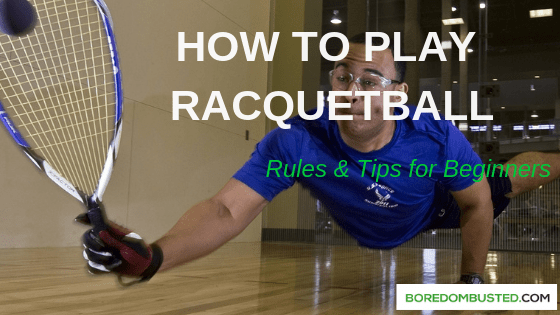Are you a beginner looking to learn how to play racquetball? Or looking for the rules of racquetball?
Awesome! We have the best beginners guide for racquetball!
You should absolutely learn how to play this fun racquet game, and it’s a super fun hobby to get into!
Learning how to play racquetball is pretty easy, actually. You might be a beginner now, but after playing a few times, you’ll be swinging that racket around like a pro!
It’s also an extremely fun activity to do when you’re bored! So, enter the awesome, wacky, racket sport of Racquetball!
Let’s learn how to play this fun racket game!
So, What Exactly IS racquetball?
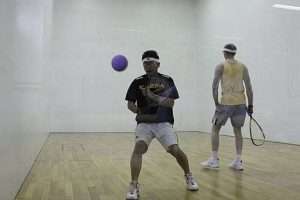
Well, imagine the “bouncy ball” elements of a huge pinball machine combined with a tennis court with no net, similar scoring rules of a volleyball game, and the childish attitude we get to hit things when we get a stick in our hand.!
Racquetball is an indoor/outdoor hybrid racquet sport that has roots in Handball and Paddleball that is extremely fun to play, relatively inexpensive, and easy to learn.
If you’ve ever sailed a tennis ball straight into the net, or high above the fence into the baseball field next door, Racquetball might just be a perfect hobby to learn.
The reason why this game is great?
Every wall, ceiling, and floor are playable surfaces and important to the game!
Related Posts:
What You Need to Play Racquetball:
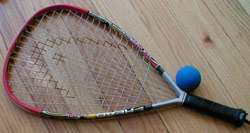
If you’re learning how to play racquetball, you’ll need to have the right equipment and playing areas to get started.
As a beginner you likely don’t have all the equipment needed to play!
Having the right racquet racket, racquetball balls, and safety glasses, are absolutely essential when you’re learning to play racquetball.
There are some optional items you can start with as well, such as specialized racquetball gloves, shoes, and a bag to hold all your items.
If you order any items from the Amazon links below, you’ll help support our website – at no additional cost to you.
Required Racquetball Equipment:
Optional Racquetball Equipment:
- Specialized Racquetball Shoes
- Racquetball Gloves
- Racquetball Bag
The Racquetball Court
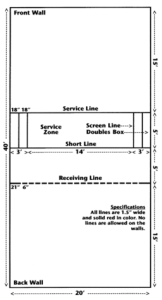
Obviously, when you learn how to play racquetball – you need a racquetball court!
Probably one of the more complex things to get used to as a beginner, the court is the focal point of every the game. So, in order to learn how to play racquetball, you’ll need to understand the court it’s played on.
Racquetball courts are interesting and unique. This sport has no “out of bounds”, net, or goal to hit the ball into. Racquetball courts are surrounded on all sides by walls and a ceiling.
All of these surfaces can be used when playing!
Which is what making this hobby so exciting!
The racquetball court is split into several different areas:
- Front Wall
- Back Wall
- Service Line
- Receiving Line
- Short Line
- Service Zone / Service Box
Envision you’re standing in the middle of the racquetball court.
The wall in front and behind of you are the “Front and Back Walls”
The dotted line about halfway in the court is the “receiving line”, which is followed by the serving box and those areas.
Learn How to Play Racquetball: The Basics
Playing A Racquetball Game – Step-by-Step
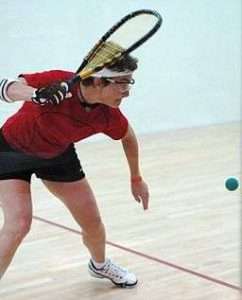
The game of racquetball is basically one big game of “keep away”.
You hit the racquetball, a small rubber ball, with the intention of not allowing the opposing player to return the ball before it touches the floor twice.
Learning how to play racquetball is pretty easy, once you get the hang of hitting the ball accurately!
-
Player 1 – Serves the ball
Player 1 bounces the racquetball ball. Mid-bounce, the player “serves” the ball – underhanded – against the front wall.
The ball cannot hit the floor before touching the front wall.
-
Player 2 – Returns the Ball
The returning player can only allow the racquetball ball to bounce once on the floor before returning serve.
Again, after the ball is struck, the ball cannot hit the floor before touching the front wall.
-
Alternate Volleys.
Both players now alternate turns “volleying” the racquetball – ensuring the ball always touches the front wall BEFORE the ground.
All walls and ceiling can be used to accomplish this.
Review volley sequence rules below.
-
Winning a Game Point
The game point is won if the ball is struck and does NOT hit the front wall before the ground OR the player allowed the ball to bounce on the floor twice before attempting to hit the racquetball.
-
Server Wins
Only the serving player can gain a point towards winning. If the server loses the point – they lose the right to serve and it goes to the other player.
-
Win the Match!
An official racquetball match is a best of 3 games. Generally, the games go to 15 points, best of three games.
If a 3rd game is necessary to break a tie, the first player to 11 points wins the racquetball match.
(15, 15, 11)
Tools:
- Racquetball racket
- Eye protection
- Rubber racquetball ball
An Example: A racquetball sequence may look something like this:
- Player 1 serves the racquetball ball by bouncing the ball once on the floor and then hitting it towards the front wall first without it touching the floor.
- After hitting the front wall with the
serve , the ball must travel beyond the “receiving line” to be hit by 2nd player. - Player 2 hits the ball with the intent of ensuring the ball touches the front wall.
- Once hitting the front wall, Player 1 will hit the ball with the same intent of hitting the front wall.
- Player 2 hits the racquetball ball, but it touches the ground before the front wall.
- Player 1 wins the point.
Racquetball Hinder: “You’re In My bubble!”
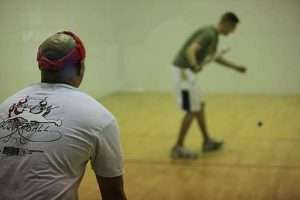
Naturally, due to the small space the game takes place, there are instances where the ball is played in an area that is currently occupied by both players.
The reason this is an issue is it affects the ability to play the ball from one player to the next.
Most of the time, this happens coincidentally and the point is replayed by both players like it never happened.
YouTube Racquetball Hinder Video
How to Serve in Racquetball: Rules, Tips, & Strategies
Much like its tennis counterpart – serving the ball in racquetball is arguably one of the most important aspects of the game. Having a decent racquetball serve shot will set you up for success throughout the games you’re playing.
Easier said than done, of course!
Much like other racket games such as tennis, racquetball has very specific rules for how to serve.
When a player serves to begin a point, there are various rules that must be followed.
If a serve fails, it’s called “fault” and the server must try again.
I’ve collected this list of serving rules from the official racquetball rules PDF. Learning how to serve in racquetball is important and is one of the best ways to improve your game play.
Rules of A Valid Racquetball Serve:
- The racquetball ball must bounce on the floor once.
- The ball must hit the front wall first.
- The ball must pass the “short line”.
- After hitting the front wall, the ball may strike one sidewall.
- The player serving receives two opportunities to make a successful serve.
- If both serves are unsuccessful, the serve goes to the next player.
- An “ace” is achieved by the server when the returning player does not hit the ball back to the front wall before the ball bounces on the floor twice.
Invalid Racquetball Serves – Also Known As “Faults”
- Short Serve – Ball is served against the front wall and lands in front of the “short line”.
- Long Serve – After the served ball hits the front wall, it is not allowed to hit the back wall, before striking the floor.
- Foot Fault – When the serving players foot or racket touches completely crosses out of the service zone.
- No Bounce Serve – Serving the ball without allowing the ball to bounce first
- Ceiling Serve – Any served ball that hits the front wall and then touches the ceiling (with or without touching a side wall).
- Three Wall Serve – A served ball that hits both side walls AFTER hitting the front wall.
- Serving before Receiver is Ready – Serving before or not allowing the receiving player to be ready results in a fault.
- Fake or Baulk – When the server attempts to deceive the receiving player into thinking they are about to serve.
Racquetball Serving Strategies & Tips
As racquetball player is allowed two serve attempts, strategies are employed by a player to try and make their serves as effective as possible.
Serves can be classified into two categories:
Aggressive racquetball serves and defensive racquetball serves.

Racquetball Serve Types:
When you’re learning how to play racquetball, serving is arguably one of the hardest things for beginners to pick up.
Many times, these serves are made in an attempt to gain an “Ace”, or the ability to win the point by not allowing the player to make a return on the ball.
When it comes to racquetball, a powerful serve can give you a significant advantage over your opponents.
In this section, we will explore a range of aggressive serves that will help you dominate the game. Each serve is categorized by its difficulty level, allowing players of different skill levels to choose the one that suits them best.
1. Drive Serve
The drive serve is one of the most basic yet effective aggressive serves in racquetball.
This serve involves hitting the racquetball ball low and hard towards the side wall, causing it to come off at a low angle. By aiming for the corners, you can create difficulty for your opponent to return the serve effectively.
Difficulty Level: Beginner
2. Z-Serve
The Z-serve is a deceptive and challenging serve that can catch your opponent off guard. It involves hitting the ball towards the opposite side wall first, making it bounce off and then hit the front wall near the corner.
The ball then travels diagonally towards the opposite corner, making it difficult for your opponent to anticipate and return.
Difficulty Level: Intermediate
3. Jam Serve
The jam serve is a powerful serve that aims to hit the opponent directly. It involves serving the ball towards the body of your opponent, making it challenging for them to react quickly and return the serve effectively. This serve requires precise timing and control to execute successfully.
Difficulty Level: Intermediate
4. Lob Serve
The lob serve is a high arching serve that aims to put your opponent in a defensive position. It involves hitting the ball high towards the ceiling, causing it to drop close to the back wall.
This serve requires excellent control and timing to ensure the ball stays deep in the court, making it difficult for your opponent to attack.
Difficulty Level: Advanced
5. Reverse-Pinch Serve
The reverse-pinch serve is a deceptive and challenging serve that involves hitting the ball with spin towards the opposite corner.
This spin causes the ball to reverse its direction after hitting the front wall, making it difficult for your opponent to anticipate and return. This serve requires precise timing, control, and mastery of spin techniques.
Difficulty Level: Advanced
6. Cross-Court Pass Serve:
The cross-court pass serve is a defensive tactic that aims to create angles and force your opponent out of position.
By hitting the ball towards the opposite side wall and making it cross the court diagonally, you make it difficult for your opponent to set up and attack effectively.
This serve requires precise timing, accuracy, and an understanding of court positioning.
Difficulty Level: Advanced
7. Z-Serve with Reverse Spin:
The Z-serve with reverse spin is a highly deceptive and challenging defensive serve. By applying reverse spin to the ball after hitting the side wall, you make it unpredictable and difficult for your opponent to anticipate and return.
This serve requires advanced skills in spin techniques, precise control, and strategic placement.
Difficulty Level: Advanced
Additionally, a racquetball ball has much more bounce and needs considerably less strength to strike. Whereas a squash ball has much less bounce and uses more strength and accuracy.
Frequently Asked Racquetball Questions

Just like all hobbies and sports, this fun racket sport has a variety of questions that get raised – especially when you’re first trying to figure out how to play racquetball.
Where to Play Racquetball?
Racquetball courts are typically found in fitness gyms, such as a local YMCA or other similar facilities.
Is Racquetball a Good Workout?
Yes, racquetball is a great workout! According to healthfitnessrevolution, a player will run more than two miles and burn between 600-800 calories when playing for an hour (60 minutes).
Playing regularly as a hobby has many health benefits, as most physical activities and sports do.
Racquetball can include some of the following benefits:
-Cardiovascular health
-Weight management
-Bone and Muscle Strengthening
-Hand-eye coordination
-Mental Agility
-Stress Reliever (who doesn’t like to hit things for fun, right?)
racquetball vs squash – What’s the Difference?
The biggest difference between these two racket sports is the size of the rackets used, as well as the ball used during play.
Racquetball rackets allow a maximum length of 22 inches, while squash allows up to 27 inches.
Additionally, racquetball balls have more bounce and needs considerably less strength to strike.
Whereas a squash ball has much less bounce and uses more strength and accuracy.
1. Racket size
2. Ball types
3. Serving Styles
4. “Out of bounds areas”
Can You Play Racquetball with More than Two Players?
Yes! You can play 3 or 4 players’ versions of racquetball.
4 players is considered a doubles match, with a set of two players playing against another set of two players.
3 player games can be played in a variety of ways, generally with all three players playing against each other.
You could also have two players playing against one player.
Who Are The Best Racquetball Players?
Check out the International Singles Ranking for a complete list of the top racquetball players around the globe.
Game of Racquetball: A Quick History
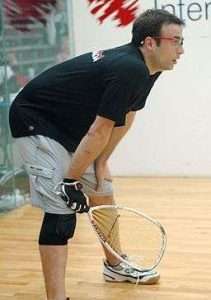
The modern game of Racquetball was invented in 1949 by Greenwich, CT resident Joseph G. Sobek (1918 – 1998). In the 1940s, Sobek, a Tennis Pro, Squash and Handball player, was dissatisfied with the indoor court sports available and sought a way to make Handball easier on his hands.He designed the first short strung paddle and with a partner, invented a game in he called “Paddle Rackets”, which combined the rules of Squash and Handball.
Per Aaronembry.com:
Paddle Rackets was a faster paced game that was easy to learn and became an overnight success. The sport quickly became popular with everyone except for die-hard Handball players who resented Paddle Racket players taking over their courts. By 1952, Sobek founded the Paddle Rackets Association, codified a set of rules and sent out promotional kits to YMCAs and other sporting organizations to promote the sport.
Racquetball Resources
Related Posts
- What is Beach Tennis? A Comprehensive Beginners Guide (2023)
- What is Speedminton / Crossminton? A Beginners Guide! (2023)
- Badminton Rules & Beginners guide: How to Play! (2023)
- Table Tennis Mastery: Your Ultimate Beginner Guide (2023)
- How to Play Squash: A Complete Guide for Beginners (2023)
- Rules of Pickleball {Complete 2023 Beginner Players Guide}

Hey Everyone!
Chritt here. I just want to say THANK YOU SO MUCH for visiting Boredom Busted. It’s been my passion project going on 7 years now.
I need a favor though. If you have found the page you landed on or explored useful in any ways – please please please share, or comment.
The more engagement on this page – the more I can continue to write and provide helpful content to my visitors like you.
I love you all and thank you again for visiting! Don’t be a stranger and hope to see you back, soon!

